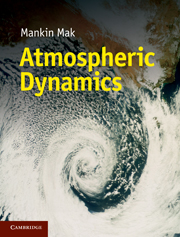Book contents
- Frontmatter
- Contents
- Preface
- 1 Fundamental concepts and physical laws
- 2 Basic approximations and elementary flows
- 3 Vorticity and potential vorticity dynamics
- 4 Friction and boundary layers
- 5 Fundamentals of wave dynamics
- 6 Quasi-geostrophic theory and two-layer model
- 7 Dynamic adjustment
- 8 Instability theories
- 9 Stationary planetary wave dynamics
- 10 Wave-mean flow interaction
- 11 Equilibration dynamics of baroclinic waves
- 12 Nongeostrophic dynamics
- Appendix: Mathematical tools
- References
- Index
- Plate section
11 - Equilibration dynamics of baroclinic waves
Published online by Cambridge University Press: 05 June 2012
- Frontmatter
- Contents
- Preface
- 1 Fundamental concepts and physical laws
- 2 Basic approximations and elementary flows
- 3 Vorticity and potential vorticity dynamics
- 4 Friction and boundary layers
- 5 Fundamentals of wave dynamics
- 6 Quasi-geostrophic theory and two-layer model
- 7 Dynamic adjustment
- 8 Instability theories
- 9 Stationary planetary wave dynamics
- 10 Wave-mean flow interaction
- 11 Equilibration dynamics of baroclinic waves
- 12 Nongeostrophic dynamics
- Appendix: Mathematical tools
- References
- Index
- Plate section
Summary
This chapter discusses some aspects of nonlinear dynamics of large-scale baroclinic waves.Section 11.1 gives a broad overview of the nature of such nonlinear dynamics and the three analyses selected for illustration. As noted in Chapter 6, the most essential aspects of the dynamics of large-scale baroclinic waves can be adequately investigated with a two-layer quasi-geostrophic model. We begin with a rudimentary discussion of geostrophic turbulence in the context of such a setting in Section 11.2. The first specific analysis presented in Section 11.3 examines the dynamics of the life cycle (LC) of baroclinic waves emerging from an unstable baroclinic jet. The crucial role of an additional barotropic shear leading to the distinct forms of LC1 or LC2 is delineated in Sections 11.3.1 and 11.3.2. We next discuss in Section 11.4 the dynamical symbiotic relation between the synoptic and planetary waves in a forced dissipative flow. The third problem analyzed in Section 11.5 is concerned with the role of nonlinear dynamics in dictating the relative intensity of the two major winter storm tracks of the northern hemisphere.
Introductory remarks
Short-term fluctuations in large-scale nonlinear atmospheric flows may be regarded as being deterministic. That is after all the raison d'être for the current practice of objective weather forecasting. The dynamical nature of such fluctuations can be interpreted as such. On the other hand, long-term fluctuations of such flows are stochastic in nature. They are referred to as geostrophic turbulence. Such fluctuations should be diagnosed statistically because only their statistical properties are reproducible.
- Type
- Chapter
- Information
- Atmospheric Dynamics , pp. 382 - 418Publisher: Cambridge University PressPrint publication year: 2011



